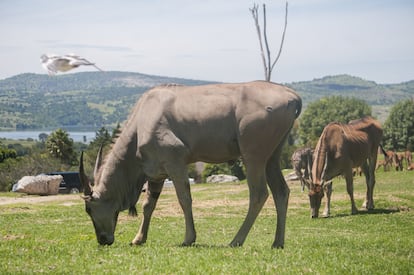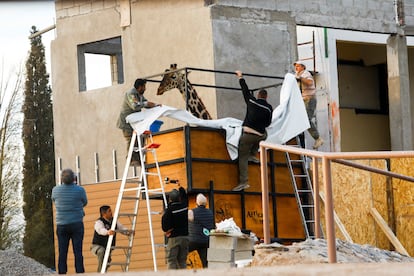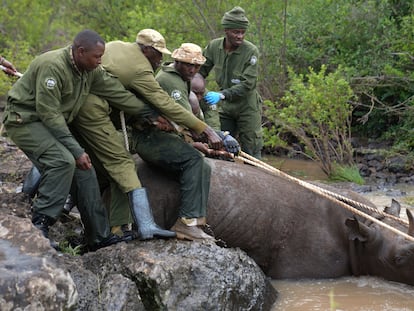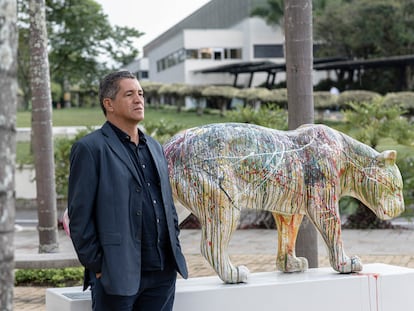This is Africam Safari, Benito the giraffe’s new home in central Mexico
Housing nearly 2,000 animals, the zoo was the first ‘safari park’ in Latin America

When one thinks of Africa, images of deserts, sand dunes and mile upon mile without a speck of shade may come to mind. However, in El Oasis de Valsequillo (Puebla, Mexico) a different African landscape unfolds. A tropical savanna climate with distinct seasons and a dense jungle awaits, ready to challenge adventurous explorers. Looking at photographs of this place, it’s easy to mistake it for Sudan or the Congo.
Discovering a tranquil oasis-like haven is no simple task — it often involves venturing to distant lands. But Carlos Camacho Espíritu knew about such a place near his Puebla birthplace. He bought the land and created a 500-acre (200-hectare) space called Africam (not a typo) Safari to provide a safe haven for wild animals. Founded in 1972, Africam Safari is not just a renowned zoo and nature preserve, but also the first safari park in Latin America. It houses nearly 2,000 animals, such as lions, bison, giraffes, lemurs and elephants. The newest resident of this incredible sanctuary is Benito, the giraffe from the northern border city of Ciudad Juárez.
Carlos Camacho, known to many as El Capitán, was born into extreme poverty in the city of Acatzingo (Puebla). At the age of 16, he traveled to the United States in search of the American dream but was immediately deported. He then settled in Monterrey (northeastern Mexico) and became a radio announcer. After saving some money, he made another attempt to emigrate north and successfully arrived in Los Angeles. Camacho soon got a job at a local radio station with a program for the city’s large Latin American community that was relegated to the pre-dawn hours. After many years living in the U.S., Camacho became a naturalized citizen. Later, he founded Mayo drug laboratories, now known as Laboratorios Camacho, with the aim of serving his fellow Mexicans.

Camacho enlisted in the U.S. Army as an aviator, reached the rank of captain, and fought in the Vietnam War. “My dad was many things,” said his daughter Amy in a 2018 interview. “Film producer, actor and entrepreneur who owned pharmacies. But his masterwork is Africam Safari.”
Carlos Camacho married Louise Wardle, an American woman he met through correspondence. Wardle was learning Spanish and wanted to hear native speakers to improve her pronunciation. At the time, Camacho had the only radio program for Mexican migrants in the United States. Wardle fell in love with his voice and they exchanged letters for a year. Eventually, she visited him at the radio station in Los Angeles, and they married two years later. The couple had eight children, two of whom, Amy and Frank, took over the park after both parents had passed away.
In 1976, Captain Camacho was attacked by a tiger named Dientes (Fangs, in English) when some tourists ignored the rules and got out of their vehicle. Camacho jumped out to help them, but was attacked by Dientes. Although the wounds didn’t kill Camacho, inadequate medical care led to septicemia (blood poisoning) and he died five days later. His widow, Louise, took over the management of the park, but she died from a brain tumor four years later. The 17-year-old Amy was left to carry on her father’s legacy.

Amy Camacho served as the CEO of Africam Safari for 40 years. She briefly worked in government (2011-2012) as the Secretary of Environmental Sustainability under former Puebla governor Rafael Moreno Valle, and passed away in 2020 from a stroke.
Her brother Frank currently serves as the CEO of the safari zoo. Previously, he was president of the International Elephant Foundation, and currently serves as vice president of the Latin American Association of Zoological Parks and Aquariums (ALPZA). Frank Camacho is overseeing the relocation of Benito, Mexico’s most famous giraffe. The 1,200-mile (1,900-kilometer) journey from Ciudad Juárez to Africam Safari should take 40-50 hours.
This is not Camacho’s first time managing the transfer of large, wild animals. In 2016, he relocated two female rhinos, Chacha 1 and Chacha 2, to the Ukumarí ecotourism and wildlife park in Colombia. He also oversaw the transfer of three African elephants, Maggi, Kim and Pirinolo, the latter being a five-ton specimen from Colombian drug lord Pablo Escobar’s Hacienda Nápoles to Ukumarí Park.
Sign up for our weekly newsletter to get more English-language news coverage from EL PAÍS USA Edition
Tu suscripción se está usando en otro dispositivo
¿Quieres añadir otro usuario a tu suscripción?
Si continúas leyendo en este dispositivo, no se podrá leer en el otro.
FlechaTu suscripción se está usando en otro dispositivo y solo puedes acceder a EL PAÍS desde un dispositivo a la vez.
Si quieres compartir tu cuenta, cambia tu suscripción a la modalidad Premium, así podrás añadir otro usuario. Cada uno accederá con su propia cuenta de email, lo que os permitirá personalizar vuestra experiencia en EL PAÍS.
¿Tienes una suscripción de empresa? Accede aquí para contratar más cuentas.
En el caso de no saber quién está usando tu cuenta, te recomendamos cambiar tu contraseña aquí.
Si decides continuar compartiendo tu cuenta, este mensaje se mostrará en tu dispositivo y en el de la otra persona que está usando tu cuenta de forma indefinida, afectando a tu experiencia de lectura. Puedes consultar aquí los términos y condiciones de la suscripción digital.
More information
Archived In
Últimas noticias
Most viewed
- Sinaloa Cartel war is taking its toll on Los Chapitos
- Oona Chaplin: ‘I told James Cameron that I was living in a treehouse and starting a permaculture project with a friend’
- Reinhard Genzel, Nobel laureate in physics: ‘One-minute videos will never give you the truth’
- Why the price of coffee has skyrocketed: from Brazilian plantations to specialty coffee houses
- Silver prices are going crazy: This is what’s fueling the rally











































